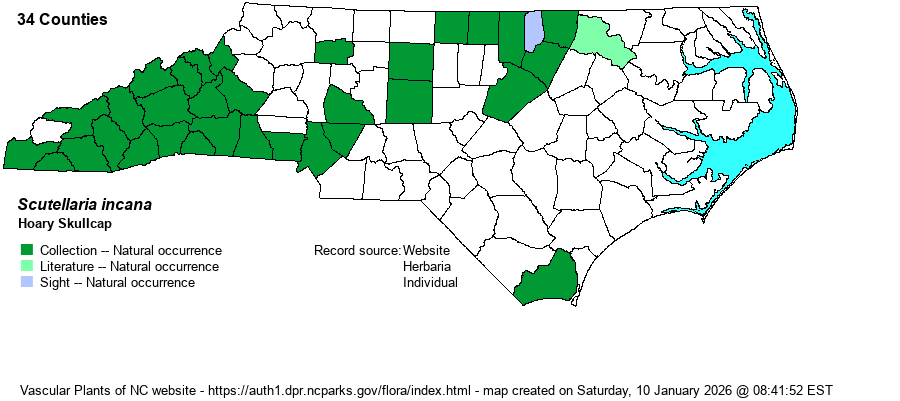| Author | Biehler | |
| Distribution | Ranges over most of the Mountains and northeastern half of the Piedmont, with a disjunct record for Brunswick County. An odd lack of records for the northwestern Piedmont and northern Mountains.
This species has an Eastern range, but with an odd distribution. It ranges from southwestern NY and MO, south to GA and LA, but it is oddly scarce in MD, VA, and also into northwestern NC. | |
| Abundance | Frequent to common in the central and southern Mountains and adjacent southwestern Piedmont. Infrequent in the north-central and northeastern Piedmont, but very rare between there and the Mountains. Casual in Brunswick County, the only Coastal Plain records. The var. australis is Significantly Rare, as listed by the NCNHP. | |
| Habitat | This is a species of shaded to partly shaded mesic hardwood forests, not in overly dry or rocky sites nor normally in bottomlands or overly rich sites. Thus, it is a species of Mesic Mixed Hardwood Forests, Acidic Cove Forests, and various oak-dominated forests, as well as stream banks, wooded margins, and roadbanks. The Brunswick County habitat is/was likely in dry, sandy open woods, as it represents a different variety from that elsewhere in the state. | |
| Phenology | Blooms from late June to early September, later than most similar skullcap species (that are normally finished by late June); fruits soon after flowering. | |
| Identification | This is a rather tall herb, especially for a skullcap, growing as a single stem to about 2-3 feet tall. It has a handful of paired (opposite) leaves, each pair often at right angles to the ones above and below, with rather long petioles often 1-inch long. The leaf blades are mostly widely elliptic, rounded to cuneate at the base and toward the tip, about 3-4 inches long and half as wide. This species is distinguish by its many (often 5 or more) fairly long racemes of flowers from some of the upper leaf axils and tip of the stem, each one containing 10-20 or more flowers. Each blue to lavender-blue flower is about 4/5-inch long, and thus when in full bloom there are often 30-50 or more flowers in bloom on a number of racemes, forming a pyramid shape. S. serrata is a shorter plant and has generally just a solitary raceme at the end of the branch, and S. ovata has heart-shaped/cordate leaves, normally quite hairy as well. You should not have trouble finding this showy species in the southern and central mountains and adjacent Piedmont foothills, though in the northeastern Piedmont it make take much more effort to find, though not a rare species there. | |
| Taxonomic Comments | Weakley (2020) lists only two varieties as occurring in NC. The nominate var. incana is absent. The var. punctata is found in the Mountains and Piedmont. The var. australis is a southern taxon ranging north to Brunswick County.
| |
| Other Common Name(s) | Downy Skullcap | |
| State Rank | S4 | |
| Global Rank | G5 | |
| State Status | | |
| US Status | | |
| USACE-agcp | | |
| USACE-emp | | |

